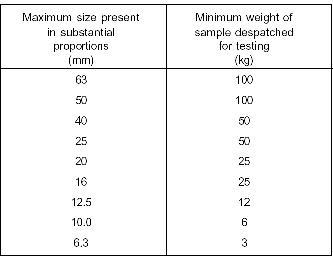SIEVE ANALYSIS
Sieve analysis helps to determine the particle size distribution of the coarse and fine aggregates.This is done by sieving the aggregates as per IS: 2386 (Part I) – 1963. In this we use different sieves as standardized by the IS code and then pass aggregates through them and thus collect different sized particles left over different sieves.
The apparatus used are –
i) A set of IS Sieves of sizes – 80mm, 63mm, 50mm, 40mm,31.5mm, 25mm, 20mm, 16mm, 12.5mm, 10mm, 6.3mm,4.75mm, 3.35mm, 2.36mm, 1.18mm, 600µm, 300µm, 150µm and 75µm.
ii) Balance or scale with an accuracy to measure 0.1 percent of the weight of the test sample.
The weight of sample available should not be less than the weight given below:-

The sample for sieving should be prepared from the larger sample either by quartering or by means of a sample divider.
Procedure to determine particle size distribution of Aggregates.
i) The test sample is dried to a constant weight at a temperature of 110 + 5oC and weighed.
ii) The sample is sieved by using a set of IS Sieves.
iii) On completion of sieving, the material on each sieve is weighed.
iv) Cumulative weight passing through each sieve is calculated as a percentage of the total sample weight.
v) Fineness modulus is obtained by adding cumulative percentage of aggregates retained on each sieve and dividing the sum by 100.
Reporting of Results
The results should be calculated and reported as:
i) the cumulative percentage by weight of the total sample
ii) the percentage by weight of the total sample passing through one sieve and retained on the next smaller sieve, to the nearest 0.1 percent. The results of the sieve analysis may be recorded graphically on a semi-log graph with particle size as abscissa (log scale) and the percentage smaller than the specified diameter as ordinate.
If you have a query, you can ask a question here.



Please,Advice/testing procedure of Flakiness & Elongation Details & IS limit for RMC Concrete &
RCC Concrete
I am new student of civil engineering i need new and modern information about civil engineering.anyboby who have new information please share
hi i am a new student studing civil engineering and i need some assistance on how to approach this field
hai
i need the information on national level conferences in civil engineering
(in india). if may know plz share it.
hi, i want information about above M60 concrete mix design.
hi, sir
i want information about above m100 concrete mix design.
what is the accuracy of the balance used in sieve analysis?
a dear hiiiiii to every civil engg. out there.
i need assistance in choosing feild of civil engg.which one is better
const. of building or highways or structural or survey right now .
regards
sarabjeet
Hi Sarabjeet,
Choosing the field purely depends on ur interest and nothing is best,everything is equal.
SPECIFICATION OF WATER BORN 40MM COARSE AGGREGATE WITH REFRENCE TO ISO CODE
I need the information of sieve anlysis in aggregate
Can you please let me know how to do a sieve analysis for a mineral sample
(eg. for a Fluorite) to get idea about the grain sizes in the samlpe.
I need the information of sieve analysis for a Fluorite mineral sample.
why do we have to use oven dried sample in sieve analysis?
Dear Sir,
Please give the IS standard for the fineness modulus for fine aggregate and coarse aggregate which can be used for RCC works of M25,M30 etc.
Dear sir,
I have same question as above…
Please give the IS standard for the fineness modulus for fine aggregate and coarse aggregate and their limits which can be used for RCC works of M25,M30 etc.
I am grateful to the developers of this such a wonderful website who helps to gather and share informations on civil engineering, for the civil engineers. It is helping me a lot to my practice.
halo everbody…
to who have information about dry sieve,wet sieve,cube casting and the slump test procedure please share with me..i need this procedure…..
I would to know all the steps used in the lab for sieves analysis( hand sieves), for civil eng( biginner)
dear sir,
I would to know all the steps in the sieves analysis
I would like to know if the sieve analysis is done manually on aggregates, should we try to see whether aggregates pass through the mesh even after manual vibration (i.e. by using hand-if there are small pieces that have not gone to through mesh, manually seeing whether they pass)